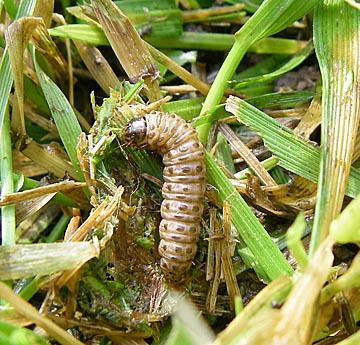 Sod webworms are a common pest in cool-season putting greens in late summer. However, recognizing the damage they cause often can be confused with stress caused by other factors such as disease, heat or drought.
Sod webworms are a common pest in cool-season putting greens in late summer. However, recognizing the damage they cause often can be confused with stress caused by other factors such as disease, heat or drought.It's important for professional turfgrass managers to recognize the signs to correctly diagnose the problem when sod webworms make their presence known.
Bobby Walls, Ph.D., of FMC Professional Solutions offered some tips to help superintendents tell the difference between damage from sod webworms and damage from heat and drought stress.
According to Walls, sod webworm larvae are easy to recognize for those who know what they are looking for. They vary in color from gray or light green to tan or brown, and they reach a length of about 1 inch.
Areas of damaged turf materialize as small brown patches that often run together into larger and irregular-shaped areas of damaged turf. The pest burrows into tunnels in thatch during the day and emerges at night to feed, attacking the leaves and stems of turfgrass plants just above the crown. This nighttime feeding ritual of the sod webworm explains how damage occurs before the pest is detected. The presence of large flocks of birds, namely starlings, gathering in the turf to feed is another indicator of sod webworm presence.
The most severe damage typically occurs in July and August, according to information from Purdue University.
A soap drench solution of two tablespoons of liquid detergent per gallon of water is an effective way to flush and monitor sod webworm movement.
The recommended threshold for sod webworms, according to Walls, is 10-15 worms per square yard. Other researchers indicate higher threshold levels of several dozen, with 10-30 pests per square yard being enough to attract birds looking for a free meal. An information sheet from Purdue sites threshold levels of four to six pests per square foot.
According to John Deere Landscapes, popular control methods include endophytic turfgrasses. Some products such as chloronicotinyl and spinosad-based insecticides can be used preventively when the pest is still in the larval stage. Products like pyrethroids, such as those with the active ingredient bifenthrin, can be effective curative controls.

